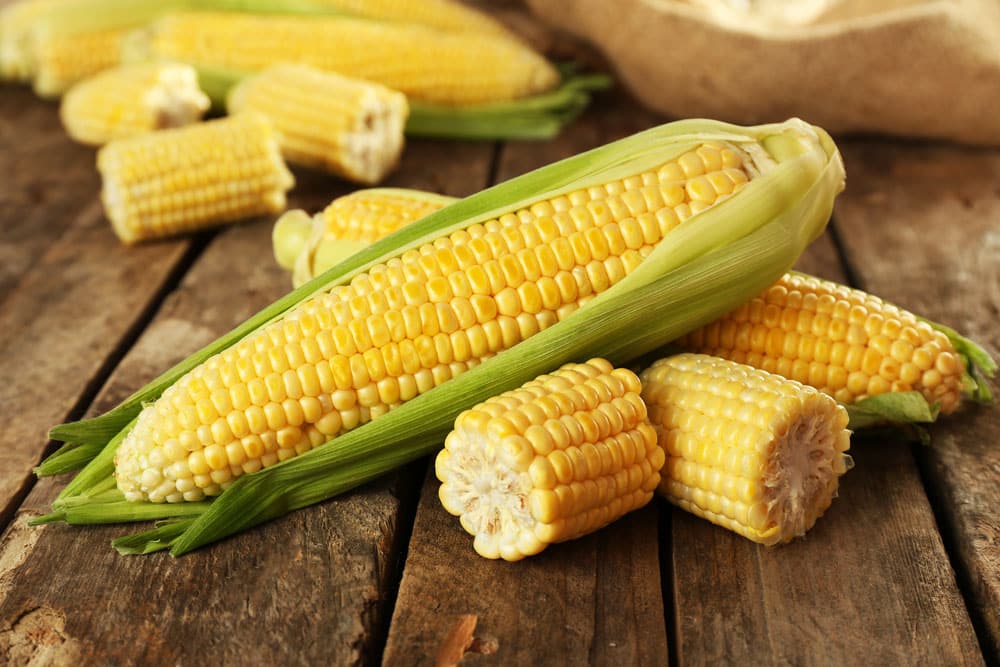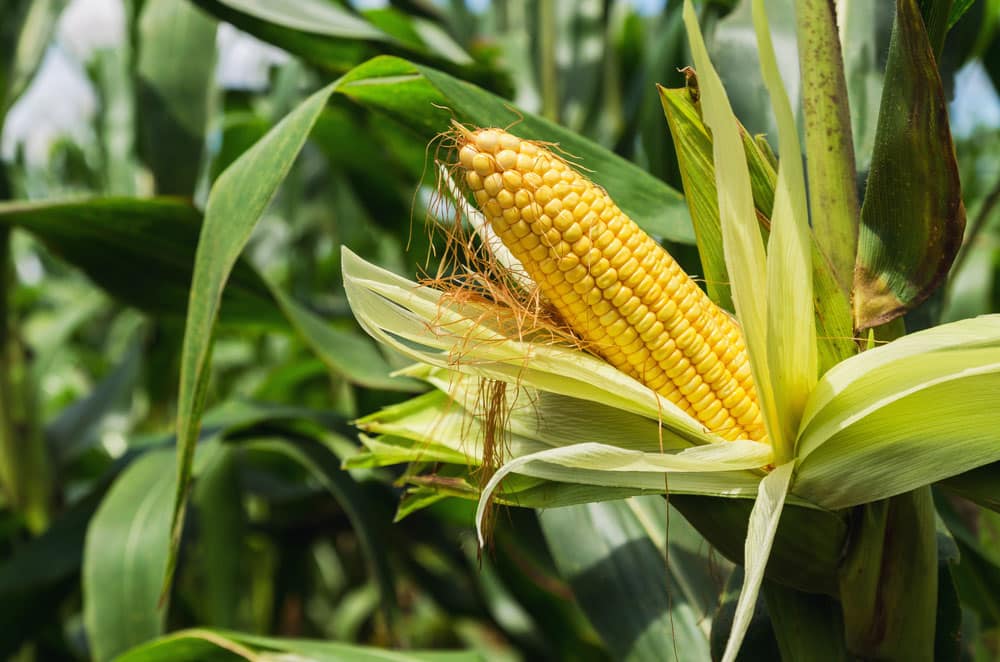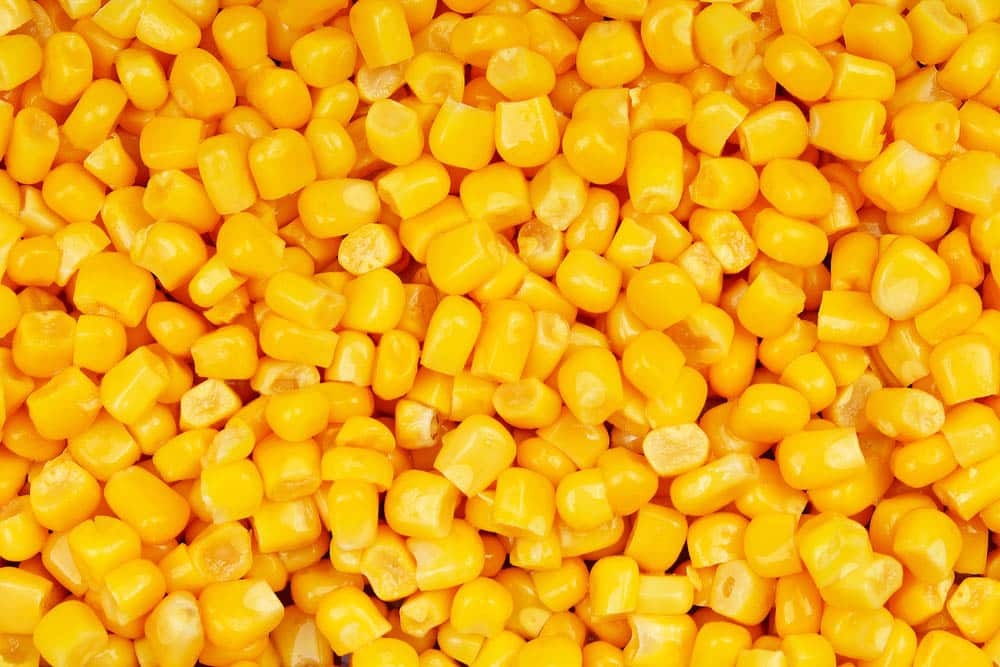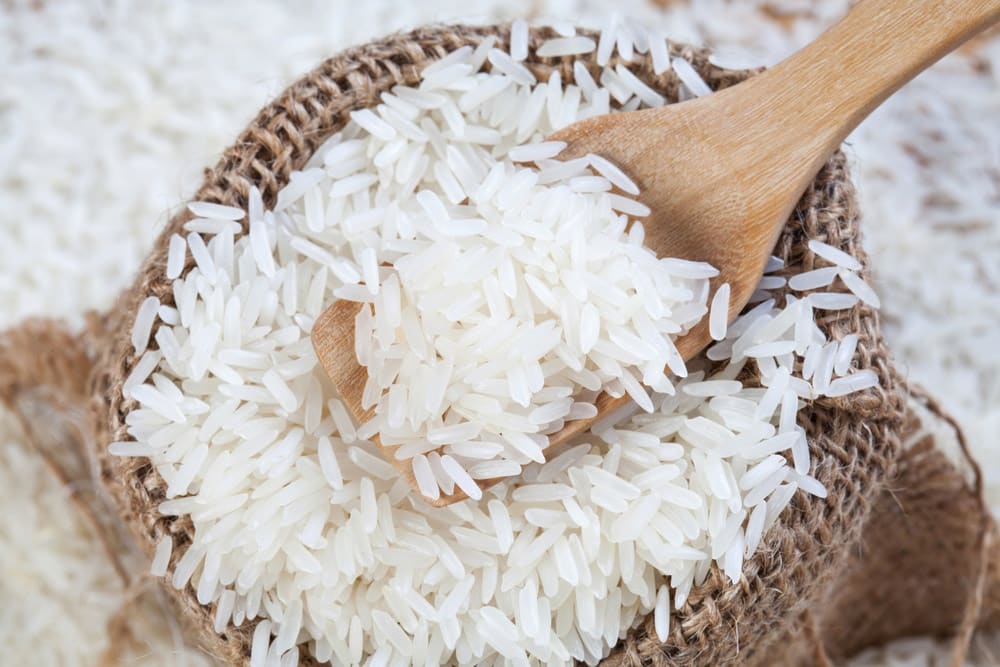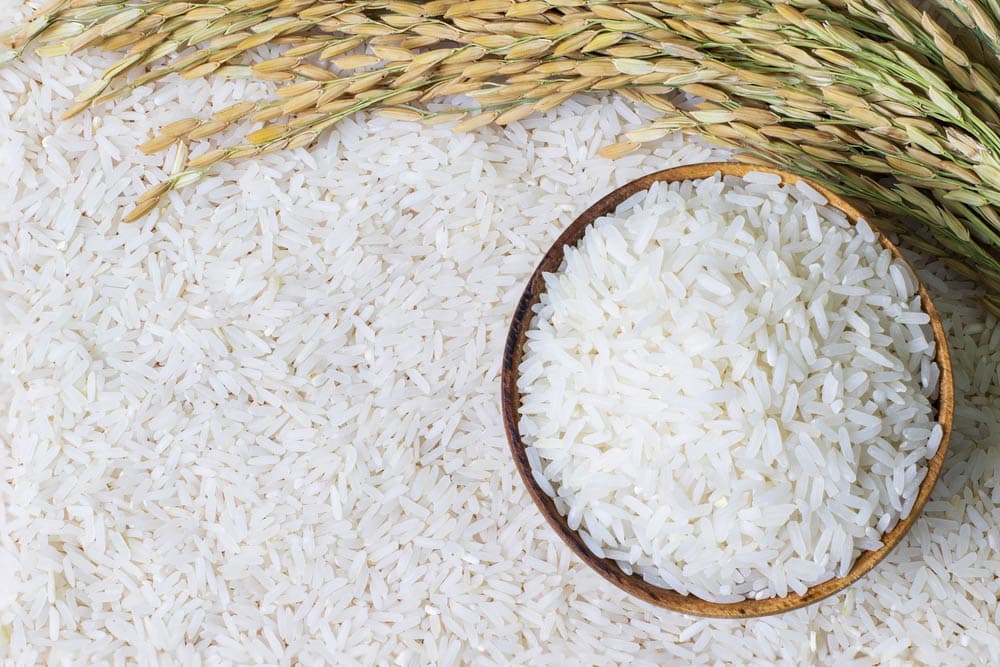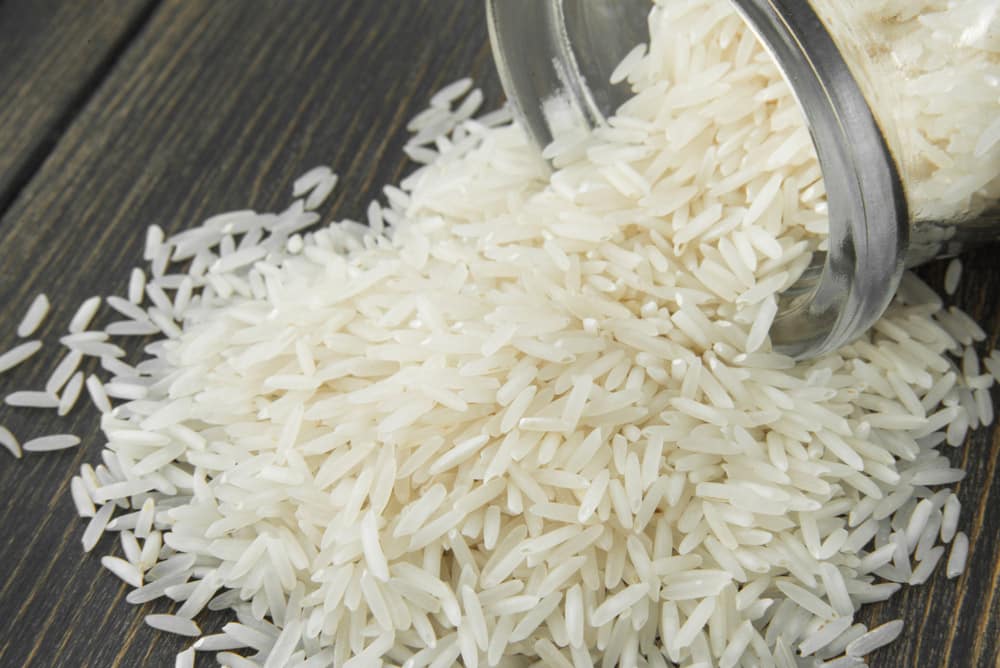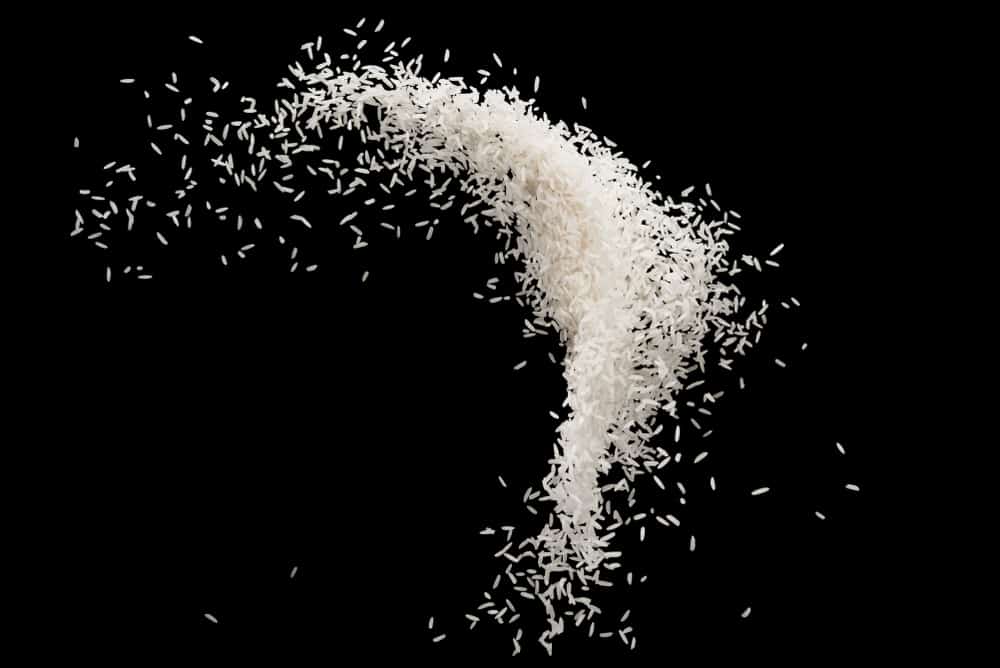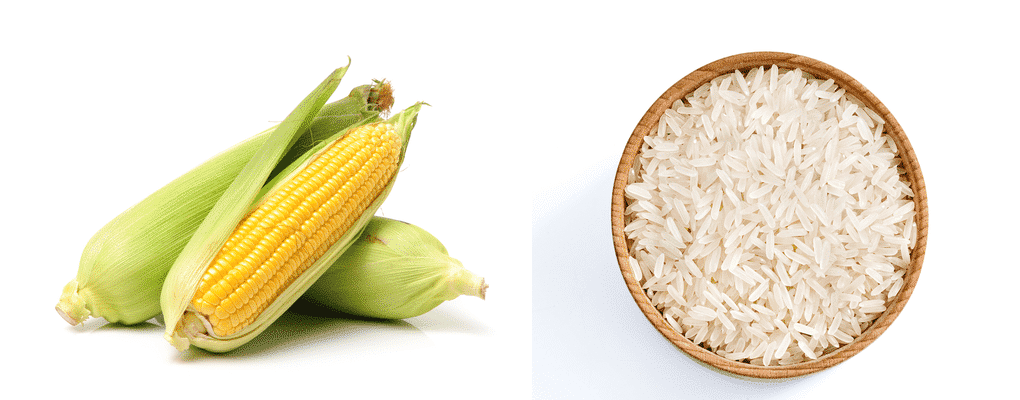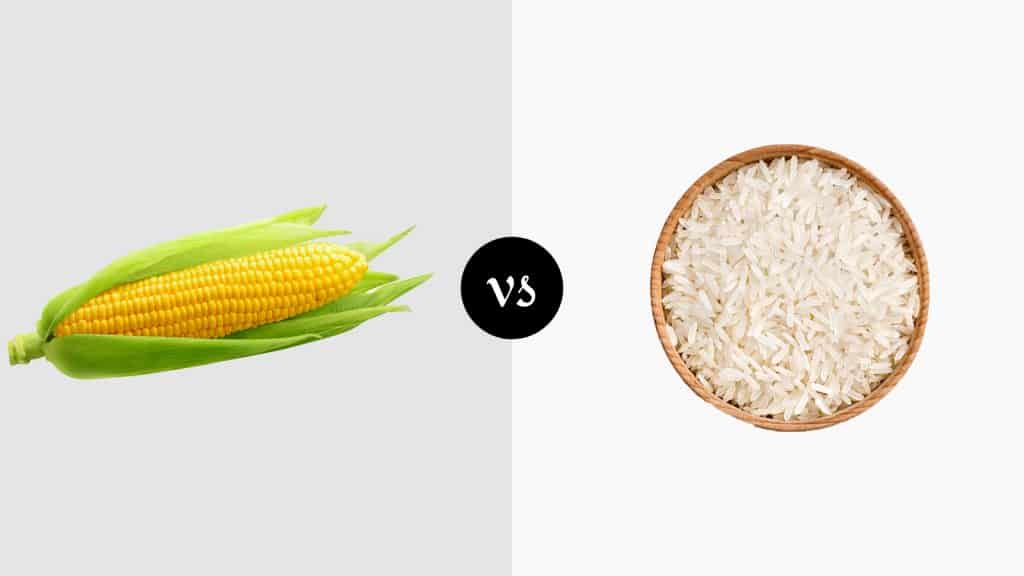
What do you like to eat more often? A corn-rich diet or rice? It’s a hard bargain if you ask me because I’m fond of both.
But in case you’re wondering which of these two tasty ingredients, corn vs. rice, is better or healthier than the other, we’ve got everything you need to know covered in our upcoming comparison.
Corn Vs. Rice Comparison
| Corn | Rice | |
|---|---|---|
| Definition | Warm Season Cereal Grain Cultivated All Year Around That Has Both Food And Industrial Uses | Cereal Grain Grass Seed Harvested From Oryza Sativa & Oryza Glaberrima - Consumed By Half The World - Third Highest Produced Food Staple |
| Varieties | Corn/Maize - Dent Corn, Flint Corn, Pod Corn, Popcorn, Flour Corn, Sweet Corn | White Rice, Brown Rice, Basmati Rice, Jasmine Rice, Mogra Rice, Bamboo Rice, Wild Rice, Black Rice, Red Rice, Red Cargo Rice, Indrayani Rice, Sushi Rice, Purple Thai Rice, Bomba Rice, Glutinous Rice, Arborio Rice, Sona Masuri, Valencia Rice, Samba Rice, Rosematta Rice, Ponni Rice, Champa Rice, Gobindobhog, Patna Rice |
| Cultivation | United States, China, European Union, Brazil, Mexico, Egypt, Japan, Vietnam, Canada | China, India, Indonesia, Bangladesh, Vietnam, Thailand, Myanmar, Philippines, Pakistan, Brazil |
| Uses | Baked Goods, Beverages, Food Acids, Starch, Oil, Biofuel, Ethanol, Alcohol, Direct Fuel, Animal Feed | Staple Food Source - Eaten Steamed Or Boiled, Consumed Alone, As Side Meal Or Recipe Ingredient, Rice Flour Used For Baked Goods, Certain Alcohols Derived From Rice, Rice Husks Used As Fuel In Rice Industry |
| Nutrition | 3.5 Ounce Serving - 96 Calories, 3.5 G Protein, 21 G Carbs, 4.5 G Sugar, 2.4 G Fiber, 1.5 G Fat Vitamins A, K, C & E, Ascorbic Acid | 100 Gram Serving - 130 Calories, 0.3 G Fat, 0.1 G Saturated Fat, 1 Mg, Sodium, 35 Mg Potassium, 28 G Carbohydrates, 0.1 G Sugar, 2.7 G Protein, 0.4 G Fiber |
| Vitamins & Minerals | Vitamins A, K, C & E, Ascorbic Acid | Full Range Of B Vitamins Including B2, B3, B5 & B9 | Iron, Copper, Calcium, Zinc |
| Health Benefits | Great Source Of Antioxidants, Prevents Disease, High In Lutein & Zeaxanthin For Eye Health | Source Of Rapid Energy, Easy To Digest, Gluten-Free |
| Forms | Fresh, Frozen, Dried, Processed Into Corn Syrup, Ethanol & Alcohol, Manufactured Into Plastics, Adhesives, Fabrics, Ornamental Growing | Short, Medium & Long Grain Rice | Rice Flour | Rice Starch | Rice Alcohol |
Corn Vs. Rice
We’ve each got our favorite, but neither corn nor rice are ingredients that any of us could live without. Learn all the facts, uses, and cultivation information about these two tasty food items. Here’s a breakdown of corn vs. rice.
Corn
Cooking without cornflour is a tragedy some chefs can’t even begin to imagine, whereas who would want a world where fresh, tasty corn on the cob can’t be served up with a slather of butter and/or liberal spice?
Corn is available in countless forms, each as tasty as the other, but cooking and eating aren’t its only uses. Here’s a breakdown of corn and everything you need to know about this essential crop.
What Is Corn?
Corn is better known to most as maize. This warm-season crop that originally grows annually is today cultivated all around the world all year round with the help of greenhouses and science.
The cereal grain with the binomial name Zea mays has been consumed for over 10,000 years and is still a food staple processed into countless forms. More corn grows in the Americas than any other crop, and it is used in widespread industries from alcohol to oil and biofuel production.
Varieties
Corn, also known as maize, is available across six commercially cultivated varieties, namely dent corn used for flour, flint corn used ornamentally and popped like popcorn, pod corn a mutation grown for Native American religious prominence, popcorn, flour corn used to make corn flour in various geographical regions, and sweet corn which is the most consumed across all its incarnations fresh, canned and frozen.
Cultivation
The United States produces the most maize, followed by China, the European Union, Brazil, Mexico, Egypt, Japan, Vietnam, and Canada.
However, all the other unlisted regions in the world combined total as much corn output as China which is just behind the US with an estimated 272.6 million tons.
The USA produces 360.25 million metric tons of corn, of which 85% is genetically modified. Far more corn is cultivated than rice.
Uses
Corn is essential to bakery goods, beverages, food acids, starch production, oil manufacturing, biofuel, ethanol and alcohol manufacturing, and sweeteners. Stalks are processed into various building materials and paper, while the discards of corn are utilized directly as a fuel source.
Additionally, a third of all the US’s corn output is grown as animal feed for the cattle industry.
Nutrition
Corn is rich in protein, plant sugars, and fiber. The exact nutrition offered depends on the manner of processing that the maize has undergone.
However, a single 3.5-ounce serving of boiled sweet corn supplies 96 calories, 3.4 grams of protein, 21 grams of carbs, 4.5 grams of sugar, 2.4 grams of fiber, and 1.5 grams of fat.
Vitamins & Minerals
Corn is usually rich in fat-soluble vitamins such as vitamin A, vitamin K, vitamin C, ascorbic acid, and vitamin E.
Health Benefits
As a crop that’s high in vitamin C, corn offers excellent antioxidant benefits, keeping cells safe from degenerative and oxidative damage while reducing the risk of diseases.
Yellow corn, in particular, is very high in lutein and zeaxanthin, which are highly beneficial to ocular health and help lower the chance of developing cataracts later in life. The potassium in maize helps heart and muscle function while regulating blood pressure effectively.
Forms
Corn is available fresh and frozen in processed and unprocessed varieties for direct consumption as a food or use as a food ingredient. Maize is also processed into ground dried maize called cornmeal and cornstarch.
Cornstarch is hydrolyzed into corn syrup and is also fermented into ethanol for use in medicines, beverages, and industrial applications. Corn flour is milled from corn and used for baked goods. Maize is grown as food for animals and as an ingredient in animal food products.
Maize starch is converted into plastics, adhesives, and certain fabrics. Feed maize is a popular form of biofuel, as is maize-derived ethanol. Certain varieties of maize are popular for their colorful, vivid appearance and are grown for ornamental purposes.
Rice
So many meals simply wouldn’t feel complete without a steaming bowl of rice ready. Food would be severely limited if you took rice out of the equation. Let’s take a closer look at all the forms of mankind’s favorite food staple.
What Is Rice?
Rice is a cereal grain grass seed harvested from various species of Oryza sativa and Oryza glaberrima, namely Asian and African rice. Over half of all the world’s populace eat rice, and it’s the third-highest produced food staple falling just behind corn.
Rice grows anywhere but is better suited to high rainfall, tropical areas where the annual plant thrives perennially instead.
Varieties
Oryza sativa and Oryza glaberrima are cultivated across the world primarily by developing countries that grow 95% of the planet’s rice.
The most common exact varieties of rice found commercially are
- white rice
- brown rice
- basmati rice
- jasmine rice
- mogra rice
- bamboo rice
- wild rice
- black rice
- red rice
- red cargo rice
- Indrayani rice
- sushi rice
- purple Thai rice
- bomba rice
- glutinous rice
- arborio rice
- sona masuri
- valencia rice
- samba rice
- rosematta rice
- ponni rice
- Champa rice
- gobindobhog
- and Patna rice.
Cultivation
The top rice-producing countries in order of output are China, India, Indonesia, Bangladesh, Vietnam, Thailand, Myanmar, Philippines, Pakistan, and Brazil. Chinese rice production tallied approximately 211.86 million metric tons in 2020.
Uses
Rice is predominantly a staple food. It is either cooked by means of steaming or boiling and then consumed. Cooked rice is eaten alone or as a side or as a component/ingredient of a recipe. Rice flour is made from rice ground down to powdery consistency.
There are also certain cereals and kinds of pasta produced from rice and rice flour. Rice wine-like sake and Korea’s makgeolli are made from rice. Rice husks are used as fuel in certain industries, especially the paddy processing sector of rice harvesting.
Rice husk and its ash are also at times processed as a source of superfine silica.
Nutrition
Rice is gluten-free and supplies a balanced range of over fifteen vitamins and minerals.
A single 100-gram serving supplies 130 calories, 0.3 grams of total fat, 0.1 grams of saturated fat, 1 mg of sodium, 35 mg of potassium, 28 grams of carbohydrates with just 0.1 grams of sugar, 2.7 grams of protein, and 0.4 grams of dietary fiber.
In today’s world, rice is such a prominent food staple that it contributes to 20% of the caloric intake of the world. Rice contains a high level of carbohydrates, inclusive of starch and calories, with a higher GI index than corn.
Vitamins & Minerals
Rice is rich in water-soluble vitamins, which means all types of B vitamins. This includes B2 (riboflavin), B3 (niacin), B5 (pantothenic acid), and B9 (folic acid). It is also rich in iron, copper, calcium, and zinc.
Health Benefits
Eating rice fuels one with a rapid source of quick metabolizing energy. White rice helps glycogen levels replenish, which are depleted after strenuous activity like exercise. This makes eating rice excellent for getting yourself back to high energy levels after a workout.
All varieties of rice are rich in fiber, with brown rice offering the best digestive benefits. There are very few people who can’t eat rice due to its easy-to-digest nature and high palatability. Even those with food sensitivities are typically allowed to eat rice.
Forms
Rice is available in long, short, and medium-length grains. There is also rice flour, rice starch, and rice alcohol commercially produced, and a limited number of fuel-based uses resort to using rice byproducts like husks and related fuel derivatives.
What Is The Difference Between Corn Vs. Rice?
The main difference between corn and rice is that rice is grown almost exclusively for consumption, whereas corn has food, fuel, and industrial applications that span many industries. Corn is more widely cultivated than rice, but rice is most widely consumed.
Corn Vs. Rice, Final Thoughts
A balanced diet should include both corn and rice, but neither should be consumed constantly simply to fill a food quota and fend off hunger.
Take the time to consider what you’re eating and in which ways you’re getting in maize and rice, and adjust your diet as is needed to secure you the best health and energy levels. There’s no winner between corn vs. rice but rather a balance that will suit your diet and lifestyle best.
